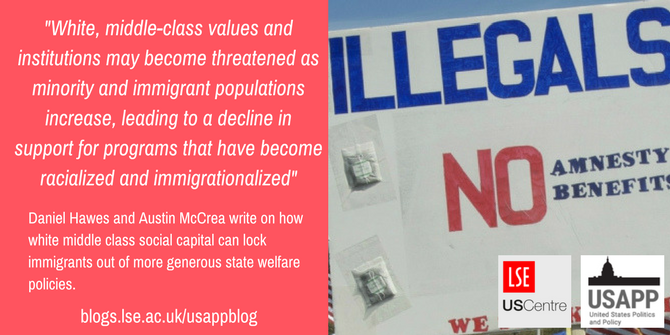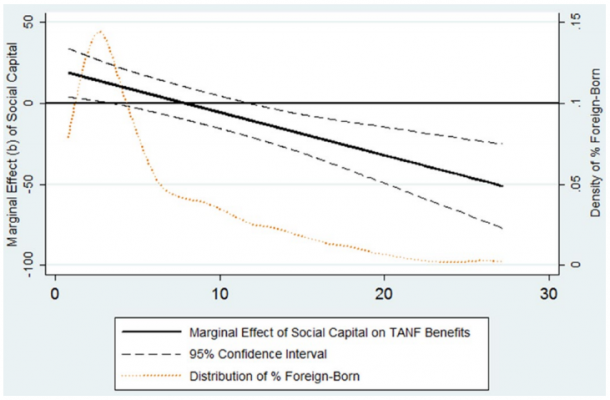
 Social capital is often a positive force in communities: it can help connect individuals and help societies run more smoothly. But, it can also work to enforce controls against those who society perceives to be rule-breakers. In new research which examines social capital’s role in influencing states’ welfare provision, Daniel Hawes and Austin McCrea find that as a state’s immigrant population increases, social capital has a negative effect on welfare generosity. The authors write that as many welfare programs have become influenced by discourses about “illegal immigration”, social capital can mobilize the grassroots to oppose more generous welfare policies for immigrants.
Social capital is often a positive force in communities: it can help connect individuals and help societies run more smoothly. But, it can also work to enforce controls against those who society perceives to be rule-breakers. In new research which examines social capital’s role in influencing states’ welfare provision, Daniel Hawes and Austin McCrea find that as a state’s immigrant population increases, social capital has a negative effect on welfare generosity. The authors write that as many welfare programs have become influenced by discourses about “illegal immigration”, social capital can mobilize the grassroots to oppose more generous welfare policies for immigrants.
The United States has undergone significant population change in the last century. As a result, some communities are becoming increasingly diverse and have to make public policy decisions with their new communities in mind. One important policy area in the debate about race and demographic change is social welfare. In 1996, Congress passed the Personal Responsibility and Work Opportunities Reconciliation Act (PRWORA). One major implication of the legislation was that the benefit program Aid to Families with Dependent Children (AFDC) was replaced with Temporary Aid for Needy Families (TANF). This welfare reform allowed states to exercise significant discretion in welfare decisions, including eligibility and benefit levels. Existing research finds that states with larger minority populations often institute more punitive welfare eligibility requirements and have lower cash benefits.
In our research, we examine the case of immigrants and welfare generosity. The Latino population is an important target group given the “immigrationalization” of welfare in the media, where some individuals and policy-makers associate issues of social welfare with an immigrant population that abuses the system and taxpayer dollars. We find that as a state’s immigrant population increases, states with greater levels of social capital see a decline in welfare generosity.
Social capital, social control, and social empathy
An important mediating factor in how immigrant groups are perceived is through social capital. Social capital is most commonly defined in Robert Putnam’s 2000 work, Bowling Alone as “connections among individuals” or “social networks and the norms of reciprocity and trustworthiness that arise from them”. With social capital come norms and trust that act to reinforce social compliance, civic participation and co-production that makes society function more smoothly. Importantly, social capital can be activated for forms of social control or social empathy. We argue that social control exists when society perceives that individuals break their obligations and expectations to society. In response, social capital may act to enhance these controls, and some states therefore adopt more punitive policies that deal with those who are “taking advantage of the system.” On the other hand, social capital may also generate empathy, where “norms of reciprocity” encourage altruism and increases empathy for those less fortunate than themselves.

“ILLEGALS” by Tim Pierce is licensed under CC BY 2.0
The perceptions of immigration in the media and society at large also play an important role in these processes. Areas with high levels of social capital put a premium on prudent behavior and adjudicate compliance through punitive social controls. The targets of control are the “bad citizens,” whose social problems are a personal choice. Society aims to construct “prudent subjects” because those who do the disciplining (policymakers) know what is best for society to flourish. Where social capital is high, this regime is more easily enforced due to the generalized norms that impart this behavior. Individuals with similar characteristics are perceived as “democratic citizens” and these societies attempt to minimize the presence and threat of “bad citizens.”
Immigrants, particularly unauthorized immigrants, are often painted as “bad citizens.” They made a personal choice to enter this country illegally and as such must comply with the guidelines established within the communities they inhabit. Areas that are racially homogenous respond to increased immigration in a visceral manner. We theorize that the public encourages policymakers to enact tighter welfare requirements in hopes that the influx of immigrants either flee their communities or conform to existing notions of a “democratic citizen.”
Social capital may be at odds with racial threat
We utilize data from 1997-2009 to capture the effects of the post-PRWORA welfare regime on state discretion and welfare decisions. Our empirical results, shown in Figure 1 below, suggest that the form of social capital that influences state public policy is conditional upon different racial/ethnic contexts. Social capital results in greater social empathy and welfare generosity when immigrant group size is small. However, as the number of immigrants in the state increase, social capital has a negative effect on welfare generosity. Our findings suggest that social capital may be at odds with – and perhaps triggered by – racial threat. White, middle-class values and institutions may become threatened as minority and immigrant populations increase, leading to a decline in support for programs that have become racialized and immigrationalized. States with high social capital may be particularly effective at influencing these policies since social capital can be an important tool in grassroots organization and mobilization. Therefore, political responses to group/racial threat may be most effective where social capital is high.
Figure 1 – Marginal effect of social capital on TANF benefits conditional on % foreign-born

Note: Estimates based on two-way fixed-effects model with panel-corrected standard errors. TANF = Temporary Aid for Needy Families
Social capital, as measured in our analysis, primarily captures white-middle class values and it is important to note that social capital is not a proxy for racism per se and that high social capital states are not inherently more racist. Rather, social capital makes governments more effective at achieving their policy goals. When policies such as welfare and criminal justice have become racialized, social capital exacerbates the racial disparities implicit in these policy designs. Higher levels of social capital allow citizens to have a more direct connection in government since citizens are more fully engaged and connected to public affairs. Social capital allows for greater transparency between citizens and policy-makers. When a target group is attached to these policies, we expect to see greater inequality in policy outcomes.
- This article is based on the paper, ‘Give Us Your Tired, Your Poor and We Might Buy Them Dinner: Social Capital, Immigration, and Welfare Generosity in the American States’ in Political Research Quarterly
Please read our comments policy before commenting.
Note: This article gives the views of the author, and not the position of USAPP – American Politics and Policy, nor the London School of Economics.
Shortened URL for this post: http://bit.ly/2si6G40
_________________________________
 Daniel P. Hawes – Kent State University
Daniel P. Hawes – Kent State University
Daniel Hawes is an Associate Professor in the Department of Political Science at Kent State University. His research interests deal with questions related to public policy and public administration, broadly, and substantively focus on education and immigration policy. His research incorporates aspects of public administration, public management, and state and local politics in examining questions of public policy and policy performance.
 Austin M. McCrea – Texas A&M University
Austin M. McCrea – Texas A&M University
Austin McCrea is a doctoral student in the Department of Political Science at Texas A&M University. His research, broadly defined, explores how management interacts with organizational environments. This work is largely focused on social welfare organizations such as nursing homes and hospitals with a substantive focus on performance management, managerial strategy, and diversity management.




